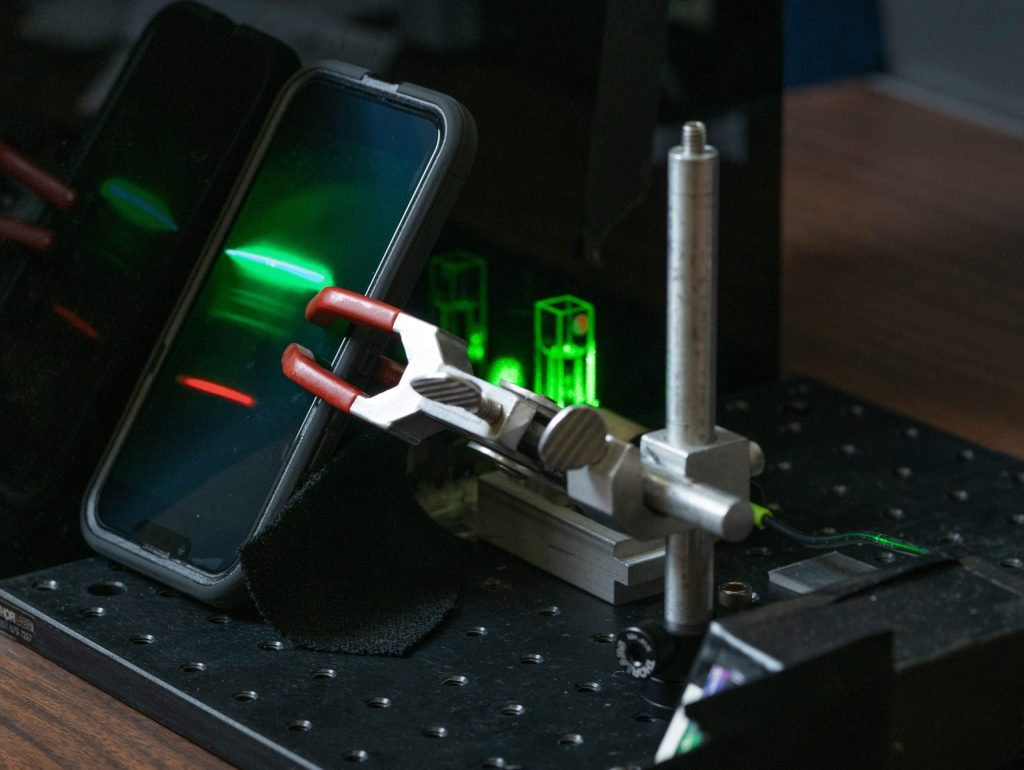The smartphone records the Raman spectrum of an unknown substance (in this case an ethanol solution) for further analysis. Credit: Texas A&M University College of Engineering
An affordable mobile phone-based Raman spectrometer system can identify unknown biological molecules in just a few minutes.
A new portable Raman spectrometer system patented by Dr. Peter Lentzepis of Texas A&M University combines a cell phone camera with laser technology to non-invasively identify harmful chemicals and materials. The device is significantly cheaper and faster than traditional spectrometers, and can be used for rapid on-site analysis in remote locations.
Imagine being able to identify safe berries and mushrooms while hiking, or quickly detect pathogens in a hospital that would normally take days to diagnose.
Combining a mobile phone camera with a powerful laser chemical analysis method, Raman spectroscopy, the technology makes it possible to identify and detect drugs, chemicals and biological molecules that are invisible to the human eye.
“The new technology will be used by a wide range of companies to develop and deliver high-performance computing,” said Peter Lentzepis, professor in the Department of Electrical and Computer Engineering. Texas A&M Universityholds a patent for a portable, cell phone based Raman spectrometer system. Lentzepis’ invention enables users to non-invasively identify potentially harmful chemicals and substances in the field, especially in remote locations where laboratory spectrometers cannot be used due to their size or power requirements.
The new Raman spectrometer system integrates lenses, diode lasers and diffraction gratings (tiny, thin, rectangular surfaces that scatter light for analysis) in combination with a mobile phone camera to record Raman spectra. Depending on their intensity and location, the peaks in the spectrum provide detailed information about the chemical composition and molecular structure of a substance.
How the device works
To use this device, simply place your mobile phone behind a transmission grating, aim the camera at the grating and prepare to record a Raman spectrum. Shine the laser beam onto a sample of an unknown material, such as bacteria on a slide. The camera records the spectrum and when combined with a suitable mobile phone application/database, this handheld instrument allows for rapid material identification in the field.
Until now, the process of identifying unknown substances has required extensive sampling of biological material and laboratory analysis, which can take hours or even days. Traditional Raman spectrometers can cost thousands of dollars, but Lentzepis’ invention can be manufactured at a significantly lower cost and can identify substances very quickly.
Cost and practicality
“These are little devices that can tell you the composition of a particular system, material or sample,” Lentzepis says, “and you can even carry them in your pocket.”
The co-inventors are Dinesh Dhankhar, PhD, a former graduate student at Texas A&M University and a systems engineer at Thermo Fisher Scientific, and Anushka Nagpal, a process engineer at Intel Corporation.
Funding for this research is administered by the Texas A&M Engineering Experiment Station (TEES), an official research organization of the Texas A&M College of Engineering.


